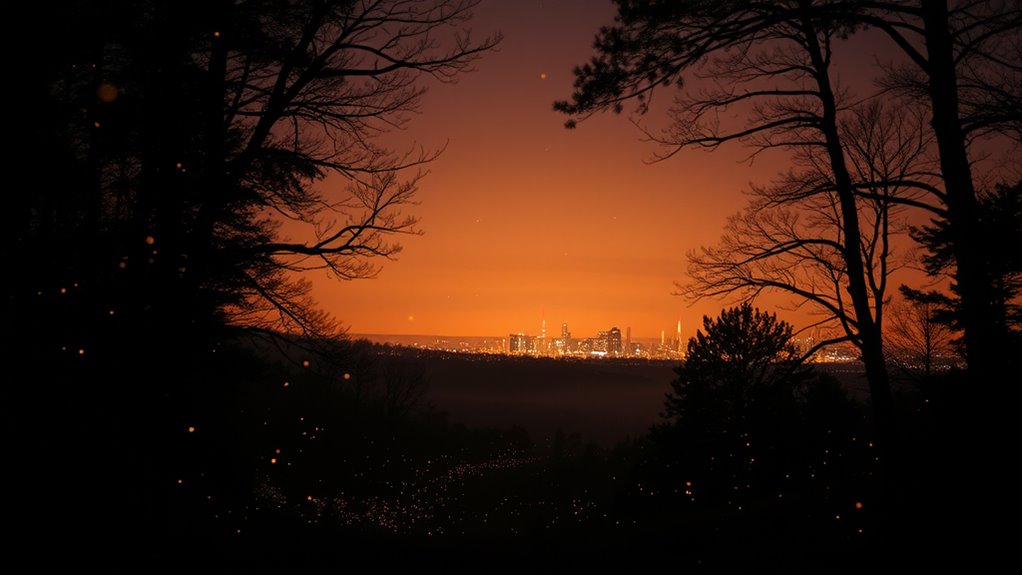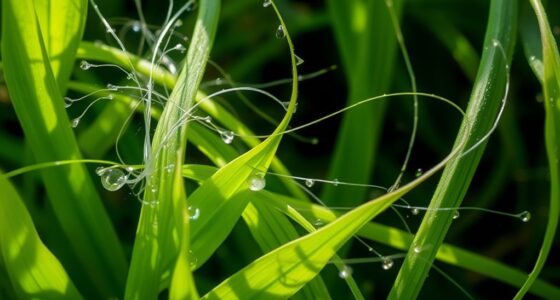Light pollution from artificial lighting disrupts fireflies’ natural flashing signals, making it harder for them to find mates and reproduce. This not only threatens their survival but also impacts the entire nighttime ecosystem they support. When you flood outdoor spaces with unnecessary light, you hinder their ability to communicate and thrive. To understand how small actions can make a difference and protect these enchanting insects, keep going.
Key Takeaways
- Artificial light disrupts firefly flashing signals, reducing successful mate encounters and causing population decline.
- Light pollution affects nocturnal ecosystems by impairing firefly roles as predators and prey.
- Reducing unnecessary outdoor lighting restores natural darkness, supporting firefly communication and reproduction.
- Restoring darkness benefits fireflies and maintains the ecological balance of nocturnal environments.
- Individual actions like turning off lights can help preserve fireflies and protect their habitats from further damage.

Light pollution is quietly threatening the enchanting glow of fireflies, making it harder for these insects to communicate and reproduce. When artificial lights flood their habitats, their natural behaviors become disrupted, affecting their ability to find mates and navigate through the night. Firefly behavior relies heavily on bioluminescent flashes, which serve as signals to attract partners and establish territories. In dark, undisturbed environments, these flashes create a mesmerizing dance that’s easy to observe. But as city lights and urban glow *intensify*, fireflies struggle to see and interpret these signals, leading to fewer successful encounters and a decline in their populations.
Artificial lights disrupt fireflies’ flashes, threatening their ability to find mates and reproduce.
The impact of light pollution extends beyond individual insects, threatening entire nocturnal ecosystems. Fireflies play a significant role in these ecosystems, acting as both predators and prey, and helping to maintain the balance within their habitats. When their flashing patterns are obscured or ignored, it’s not just their reproduction that suffers; it disrupts the intricate web of nocturnal life. Predators that rely on fireflies for food may find fewer targets, while other species that depend on fireflies for pollination or pest control can also experience setbacks. This chain reaction diminishes the overall health and diversity of nocturnal ecosystems, making them more fragile and less resilient.
As you consider the effects of light pollution, it’s clear that your actions can make a difference. Reducing unnecessary outdoor lighting, using motion sensors, and opting for lower-intensity bulbs help restore darkness to firefly habitats. These small steps can improve firefly behavior by allowing their natural flashes to shine brightly and clearly, ensuring they can communicate effectively. Restoring darkness not only benefits fireflies but also enhances the quality of life for countless other nocturnal creatures that depend on the night’s natural rhythm. Protecting these insects and their environment means safeguarding a *crucial* part of our planet’s biodiversity.
You have the power to preserve the magic of fireflies’ glow by limiting light pollution in your community. When you choose to turn off unnecessary lights and advocate for darker nights, you’re helping restore the delicate balance of nocturnal ecosystems. Every action counts toward ensuring that future generations can still marvel at the enchanting dance of fireflies under a truly dark sky. Their glow is more than just beautiful; it’s *essential* for their survival, and your efforts can make all the difference.
Understanding how light pollution affects fireflies highlights the importance of maintaining dark environments to support biodiversity.
Frequently Asked Questions
How Do Fireflies Communicate Their Presence to Each Other?
You might wonder how fireflies communicate their presence to each other. They do this through bioluminescent signals, primarily using mating flash patterns. Males and females respond to these patterns, which vary among species, helping them find mates. These flashing signals, visible in the dark, serve as a visual language that guarantees successful reproduction, but light pollution can interfere with their ability to communicate effectively.
Can Fireflies Adapt to Increasing Urban Lighting Environments?
Imagine walking through a city park at night, where fireflies still flicker faintly. You wonder if they can adapt to urban habitat loss and increasing light pollution. Some fireflies develop adaptation strategies, like adjusting their flashing times or choosing darker areas. However, their ability to thrive in bright environments is limited, and ongoing urbanization threatens their survival. Their resilience depends on reducing light pollution and preserving natural habitats.
Are There Specific Firefly Species More Vulnerable to Light Pollution?
You might wonder if certain firefly species are more vulnerable to light pollution. Yes, some species have higher habitat sensitivity and are more affected by artificial lights. These fireflies rely heavily on dark environments for mating signals, making their species vulnerability greater. You can help by supporting dark sky initiatives and reducing outdoor lighting, which preserves their natural habitats and helps protect these delicate species from the impacts of light pollution.
What Role Do Fireflies Play in Local Ecosystems?
You’re in the thick of it, realizing fireflies play crucial roles in ecosystems. They help with pollination, supporting plant growth, and influence predator-prey dynamics, keeping populations in balance. Their nighttime glow attracts mates and prey, shaping local food webs. Without fireflies, the delicate ecological dance suffers, impacting other species and plant life. Protecting them guarantees the health and harmony of your local environment, like keeping the wheels turning smoothly.
How Does Light Pollution Affect Firefly Breeding Behaviors?
You might not realize it, but artificial lighting disruption profoundly impacts firefly breeding behaviors. Bright lights interfere with their natural flashing signals, which are essential for attracting mates. This disruption can cause breeding cycle interference, making it harder for fireflies to reproduce successfully. As a result, light pollution threatens their populations, disrupting the delicate balance of their ecosystems and potentially leading to declines in firefly numbers over time.
Conclusion
As you walk through a summer evening, imagine the last time you saw fireflies dance in the dark. Sadly, that glow is fading, much like a fading photograph in too much light. With over 30% of firefly species at risk due to light pollution, it’s as if we’re turning off their flickering lanterns before they can share their magic. If we don’t act, their enchanting light may become nothing but a distant memory.









